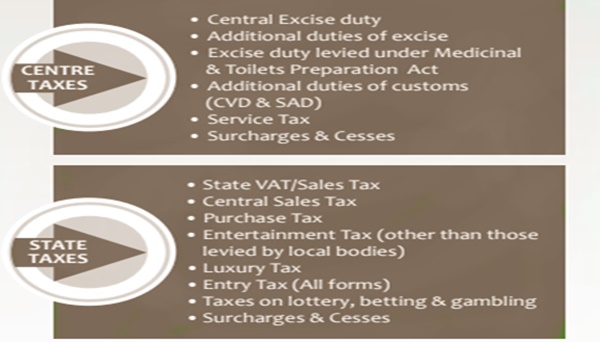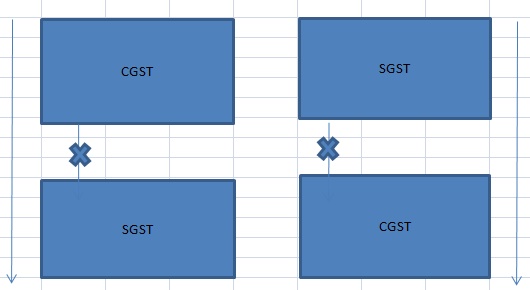Input Tax Credit Mechanism in GST
Input tax credit or “ITC” is the key features of Goods and Services Tax. its an Uninterrupted and seamless chain, ITC mechanism is prepared to avoid cascading effects of taxes. cascading effects of taxes, means, ‘Tax on Tax’. in the earlier system of taxation, the Input credit of Central Taxes being was not available as the set-off for payment of State Governments taxes, and vice versa. An important feature of the GST system is that the entire supply chain would be subject to GST to be levied by both Central and State Government. As the tax charged by the Central or the State Governments would be part of the same tax regime, the credit of tax paid at every stage would be available as the set-off for payment of tax at every subsequent stage.

Effect ‘cascading’ of taxes takes place in the earlier taxation system.
the Central excise duty charged on inputs used for manufacturing of final product can be availed as credit for payment of central excise duty on the final product.
For example,
a manufacturer requires raw material like plastic, refill tube, metal clip, etc for making a ballpen. All these ‘inputs’ are chargeable to central excise duty. Once a ‘ballpen’ is manufactured by using these inputs, the pen is also chargeable to central excise duty. Let us assume that the cost of all the above-mentioned inputs is said, Rs.20/- on which central excise duty @10% is paid, means Re.2. The cost of the manufactured pen is said Rs.30/-, the central excise duty payable on the pen @10% will be Rs.3/-. Now the manufacturer of the pen can use the duty paid on inputs, i.e. Re.2/- for payment of duty on the pen. So he will use Re.2 paid on inputs and he will pay Re.1/- through cash (2+1=3), the price of the pen becomes Rs. 33/-. In effect, he actually pays duty on the ‘value added’ over and above the cost of the inputs. This mechanism eliminates cascading of taxes. However, when the pen is sold by the manufacturer to a trader, he is required to levy VAT on such sale.
But under the present system, the manufacturer cannot use the credit of central excise duty paid on the pen for payment of VAT, as the two levies are being levied by Central and State government respectively with no statutory linkage between the two. Hence, he is required to pay VAT on the entire value of the pen, i.e. Rs.22/-, which actually includes the
central excise duty to the tune of Rs.2/-. This is cascading of taxes or tax on tax, as now VAT is not only paid on the value of pen i.e. Rs.20/- but also on tax i.e. Rs.2/-. Goods and Services Tax (GST) would mitigate such cascading of taxes. Under this new system, most of the indirect taxes levied by Central and the State Governments on the supply of goods or services or both would be combined together under a single levy. The major taxes/levies which are going to be clubbed together or subsumed in the GST regime are as under:

GST contains the following levies:
a. Central Goods and Services Tax (CGST) also called Central Tax on the intra-state or intra-union territory on the supply of goods or services or both.
b. State Goods and Services Tax (SGST) also called as State Tax on the intra-state supply of goods or services or both.
c. Union Territory Goods and Services Tax (UTGST) also called as Union territory Tax on intra-union territory supply of goods or services or both.
d. Integrated Goods and Services Tax (IGST) also called as Integrated Tax on the inter-state supply of goods or services or both. In case of import of goods also, the earlier levy of Countervailing Duty (CVD) and Special Additional Duty (SAD) has been replaced by the integrated tax.
Availing and utilization the credit of these taxes in the following manner:

Note : Credit of CGST can’t be used for payment of SGST/UTGST and credit of SGST/UTGST cannot be utilized for payment of CGST.

Technical aspects of the Input Tax Credit Mechanism :
A. Any registered dealer can avail credit of tax paid on the inward supply of goods or services or both, which is used
or intended to be used in the course or furtherance of business.
B. The pre-requisites for availing credit by the registered person :
a. He should have the tax invoice or any other specified tax paying document.
b. He has received the goods or services. “Bill to ship” scenarios also included
c. Tax is actually paid by the supplier.
d. He has furnished the return.
e. If the inputs are received in lots, he will be eligible to avail the credit only when the last lot of the inputs is
received.
f. He should pay the supplier, the value of the goods or services along with the tax within 180 days from
the date of issue of invoice, failing which the amount of credit availed by the recipient would be added to
his output tax liability, with interest
. However, once the amount is paid, the
recipient will be entitled to avail the credit again. In case part payment has been made, a proportionate
credit would be allowed.
C. Documents on the basis of which credit can be availed are:
a. Invoice issued by a supplier of goods or services or both
b. Invoice issued by recipient along with proof of payment of tax
c. A debit note issued by supplier
d. Bill of entry or similar document prescribed under Customs Act
e. Revised invoice
f. Document issued by Input Service Distributor
D. No ITC beyond September of the following FY to which invoice pertains or date of filing of annual return, whichever is earlier
E. The Input Service Distributor (ISD) may distribute the credit available for distribution in the same month in
which, it is availed. The credit of CGST, SGST, UTGST and IGST shall be distributed as per the provisions of Rule 4(1) (d) of ITC Rules. ISD shall issue an invoice in accordance with the provisions made under Rule 9(1) of Invoice Rules.
F. ITC is not available in some cases as mentioned in section 17(5) of CGST Act, 2017. Some of them are as follows:
a. motor vehicles and other conveyances except under specified circumstances.
b. goods and/or services provided in relation to:
i. Food and beverages, outdoor catering, beauty treatment, health services, cosmetic and plastic surgery, except under specified circumstances;
ii. Membership of a club, health and fitness center;
iii. Rent-a-cab, life insurance, health insurance except where it is obligatory for an employer under any law;
iv. Travel benefits extended to employees on vacation such as leave or home travel concession;
c. Works contract services when supplied for construction of immovable property, other than plant & machinery, except where it is an input service for further supply of works contract;
d. Goods or services received by a taxable person for construction of immovable property on his own account, other than plant & machinery, even when used in course or furtherance of business;
e. Goods and/or services on which tax has been paid under composition scheme;
f. Goods and/or services used for private or personal consumption, to the extent they are so consumed;
g. Goods lost, stolen, destroyed, written off, gifted, or free samples;
h. Any tax paid due to short payment on account of fraud, suppression, mis-declaration, seizure, detention.
G. Special circumstances under which ITC is available:
a. A person who has applied for registration within 30 days of becoming liable for registration is entitled
to ITC of input tax in respect of goods held in stock (inputs as such and inputs contained in semi-finished
or finished goods) on the day immediately preceding the date from which he becomes liable to pay tax.
b. A person who has taken voluntary registration under section 23(3) of the CGST Act, 2017 is entitled to ITC of
input tax in respect of goods held in stock (inputs as such and inputs contained in semi-finished or finished
goods) on the day, immediately preceding the date of registration.
c. A person switching over to normal scheme from composition scheme under section 10 is entitled to
ITC in respect of goods held in stock (inputs as such and inputs contained in semi-finished or finished
goods) and capital goods on the day immediately preceding the date from which he becomes liable to
pay tax as the normal taxpayer.)
d. Where an exempt supply of goods or services or both become taxable, the person making such supplies
shall be entitled to take ITC in respect of goods held in stock (inputs as such and inputs contained in
semi-finished or finished goods) relatable to exempt supplies. He shall also be entitled to take credit
on capital goods used exclusively for such exempt supply, subject to reductions for the earlier usage as
prescribed in the rules.
e. ITC, in all the above cases, is to be availed within 1 year from the date of issue of an invoice by the supplier.
f. In case of change of constitution of a registered person on account of sale, merger, demerger etc, the
unutilized ITC shall be allowed to be transferred to the transferee.
g. A person switching over from composition scheme under section 10 to normal scheme or where a
taxable supply becomes exempt, the ITC availed in respect of goods held in stock (inputs as such and
inputs contained in semi-finished or finished goods) as well as capital goods will have to be paid.
h. In case of supply of capital goods or plant and machinery, on which ITC is taken, an amount
equivalent to ITC availed minus the reduction as prescribed in rules (5% for every quarter or part
thereof) shall have to be paid. In case the tax on transaction value of the supply is more, the same
would have to be paid.


Permalink
Permalink
Permalink
Permalink
Permalink
Permalink
Permalink
Permalink
Permalink
Permalink
Permalink
Permalink